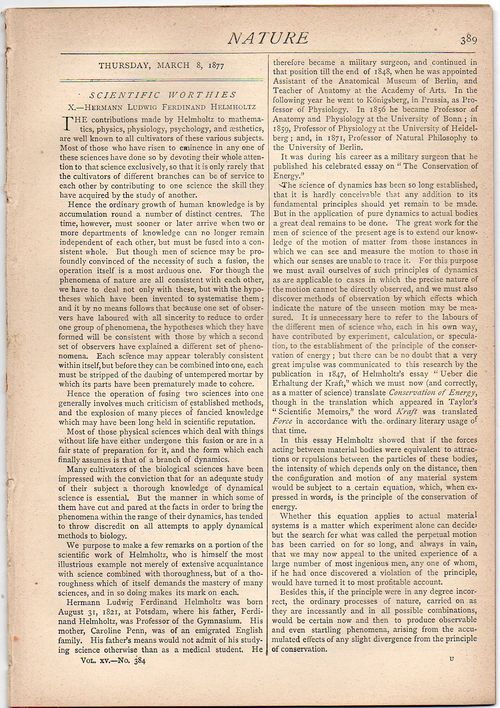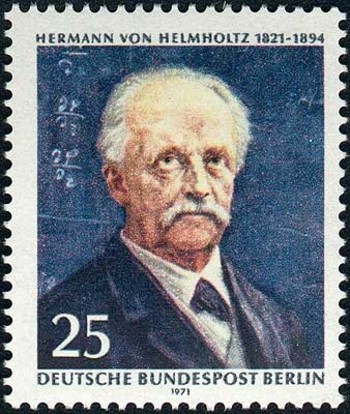 Maxwell, James Clerk. Hermann Ludwig Ferdinand Helmholtz--Scientific Worthies No. X. London: published ub Nature, 1877. [Nature, volume 15, March 8, 1877.] Original printed wrappers. Fine condition. $175.00
Maxwell, James Clerk. Hermann Ludwig Ferdinand Helmholtz--Scientific Worthies No. X. London: published ub Nature, 1877. [Nature, volume 15, March 8, 1877.] Original printed wrappers. Fine condition. $175.00
Maxwell writes a lovely appreciation of von Helmholtz--one of the premier thinkers of the 19th century and perhaps one of its most outstanding polymath (with Thomas Young, certainly), a great teacher, and evidently an outstanding person. This issue is complete with an excellent steel engraved portrait of Helmholtz. We offer the entire weekly issue of 25 pp (of which Maxwell's effort occupies several pages and about 2500 words, cleanly removed from a larger bound volume of the magazine's weekly issues.
von Helmhotz was prolific and powerful across many varied fields: he discovered the principle of the conservation of energy, invented the ophthalmoscope, did seminal work in the field of color vision and motion perception, measured the speed the the action of the human nervous system, calculated the death of the sun, wrote a foundation book in the field of acoustics (Die Lehre von den Tonempfindungen als physiologische Grundlage für die Theorie der Musik (On the Sensations of Tone as a Physiological Basis for the Theory of Music), had the Helmholtz equation named for him for his work in electromagnetism, provided a key inspiration for Alexander Bell's telephone with his Helmholtz resonator, and so on. Really--its all very very impressive. And this appreciation of him is written by one of the smartest men of the century.
I wrote this about Helmholtz in a post here on the issue of recognition--in H's case, "high recognition for the work of another physicist:
 The laws of thermodynamics have a somewhat complex parenthood, but it is the relationship of Helmholtz and Mayer in the First Law that we’re interested in here. In short, the great three laws (in short) state: Energy can neither be created or destroyed (First Law); All spontaneous events act to increase total entropy (Second Law); Absolute zero is removal of all thermal molecular motion (Third Law). Carnot (in a brilliant 124-page paper Reflections on the Motive Power of Fire), Joule and Helmholtz are generally associated with creating the First Law (with Clausius, Gibbs and Boltzmann for the Second and Nernst for the Third).
The laws of thermodynamics have a somewhat complex parenthood, but it is the relationship of Helmholtz and Mayer in the First Law that we’re interested in here. In short, the great three laws (in short) state: Energy can neither be created or destroyed (First Law); All spontaneous events act to increase total entropy (Second Law); Absolute zero is removal of all thermal molecular motion (Third Law). Carnot (in a brilliant 124-page paper Reflections on the Motive Power of Fire), Joule and Helmholtz are generally associated with creating the First Law (with Clausius, Gibbs and Boltzmann for the Second and Nernst for the Third).
It was Helmholtz who provided the mathematical proof (in 1847, in his "Ueber die Erhaltung der Kraft" "On the Conservation of Energy," ), the basis of the law of the conservation of energy. But even though he was the first in this particular part of the thermodynamics universe (which he later famously and incredibly declared in 1856 to be “dying”), he recognized the previous related work—which he evidently did not use or perhaps even know about—of Robert Mayer (1814 -1878) (1841, “Remarks on the Forces of Nature”), who basically stated that energy can be neither created nor destroyed, which is the sharp tooth of the law. The paper just showed up where it shouldn’t’ve. Helmholtz recognized its importance and later insisted on Mayer having priority in discovery—there was plenty to go around, really, and especially since it was Helmholtz who gave the law its mathematical foundation. It is just a very fine showing of intellectual appreciation and scientific ability that Helmholtz recognized the contribution of Mayer in such a fashion. (Helmholtz, a great experimenter, theoretician and teacher, makes frequent appearances in my wife Patti's blog--have a look!)




Comments